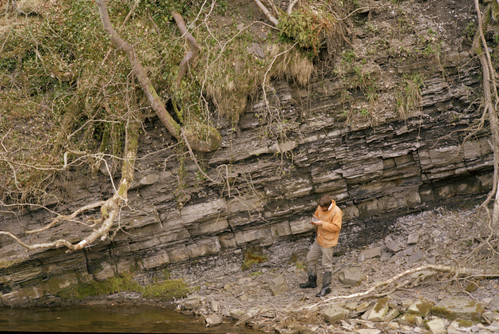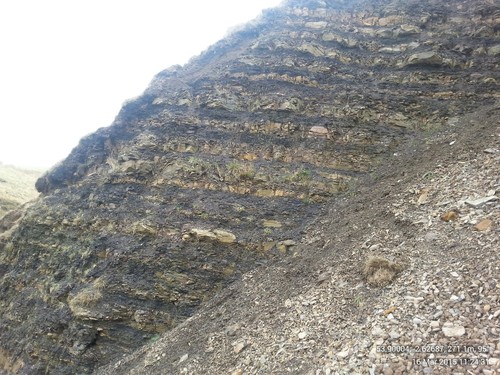The BGS has an important, impartial role to play in terms of better understanding the environmental risks and impacts that might arise from shale gas industry operations.
Shale gas is extracted from the impermeable shale rock through a process called hydraulic fracturing (also known as hydrofracking or fracking).
What are the risks associated with extracting shale gas?
Groundwater contamination
On average, around 20 million litres of water are needed during the life cycle of a well. The waste water (‘flow back’) needs to be treated properly and kept isolated from the surrounding aquifers. Other potential pathways for contamination of groundwater include poor well design or construction and the migration of contaminants along natural pathways into overlying aquifers.
Climate
Concerns include the emissions of carbon dioxide (CO2), methane (CH4) and other greenhouse gasses when the shale gas play is exploited. This also includes ‘fugitive’ emissions, which are composed of CH4 that flows to the surface after fracking and can affect the atmosphere.
Air quality
There can be a negative effect on local air quality and noise pollution caused by the many truck movements during the life cycle of a shale gas well.
Induced tremors
Induced, low-magnitude tremors, such as those experienced in Lancashire in 2011, can be a consequence of the process of hydraulic fracturing.
How does BGS research help?
The BGS is the coordinator for the pan-European Horizon2020 Subsurface Evaluation of CCS and Unconventional Risks (SECURe) project, which gathers scientific evidence relating to monitoring the environment and mitigating risk in order to guide subsurface geoenergy development.
We are also a major contributor of the NERC-funded Unconventional Hydrocarbons in the UK Energy System project. This aims to improve the understanding of unconventional hydrocarbon development in the UK, taking a holistic, interdisciplinary approach to identifying the potential environmental, social and economic impacts.
Our research is currently focused in the following main areas.
Environmental impacts and monitoring
- Fingerprinting gases using stable C and H isotope systems
- BGS groundwater research
Basin analysis
- High-resolution biostratigraphy
- Chemostratigraphy and sequence stratigraphy
- Thermal maturity (vitrinite reflectance)
- High-resolution borehole core scanning
- GIS databases and modelling
- Seismic processing and interpretation of geophysical datasets
- Wireline interpretation
- Fracture analysis
- Borehole breakouts
- Stress fields
- Rock physics modelling
- Transport and deformation properties of shales
- Microscopy
- Geochemistry
- Organic geochemistry
- National Environmental Isotope Facility (NEIF)
Further reading
Andrews, I J. 2014. The Jurassic shales of the Weald Basin: geology and shale oil and shale gas resource estimation. (London, UK: British Geological Survey for DECC.)
Andrews, I J. 2013. The Carboniferous Bowland Shale gas study: geology and resource estimation. (London, UK: British Geological Survey for DECC.)
Emmings, J F, Dowey, P J, Taylor, K G, Davies, S J, Vane, C H, Moss-Hayes, V, and Rushton, J C. 2020. Origin and implications of early diagenetic quartz in the Mississippian Bowland Shale formation, Craven Basin, UK. Marine and Petroleum Geology, Vol. 120, 104567.
Greenhalgh, E. 2014. The Jurassic shales of the Wessex area: geology and shale oil and shale gas resource estimation. (London, UK: British Geological Survey for the Oil and Gas Authority.)
Hennissen, J A I, Hough, E, Vane, C H, Leng, M J, Kemp, S J, and Stephenson, M H. 2017. The prospectivity of a potential shale gas play: an example from the southern Pennine Basin (central England, UK). Marine and Petroleum Geology, Vol. 86, 1047–1066.
Loveless, S E, Bloomfield, J P, Ward, R S, Hart, A J, Davey, I R, and Lewis, M A. 2018. Characterising the vertical separation of shale-gas source rocks and aquifers across England and Wales (UK). Hydrogeology Journal, Vol. 26, 1975–1987.
Lowry, D, Fisher, R E, France, J L, Coleman, M, Lanoisellé, M, Zazzeri, G, Nisbet, E G, Shaw, J T, Allen, G, Pitt, J, and Ward, R S. 2020. Environmental baseline monitoring for shale gas development in the UK: identification and geochemical characterisation of local source emissions of methane to atmosphere. Science of the Total Environment, Vol. 708, 134600.
Monaghan, A. 2014. [Online] The Carboniferous shales of the Midland Valley of Scotland: geology and resource estimation. (DECC website, now OGA.)
Ougier-Simonin, A, Renard, F, Boehm, C, and Vidal-Gilbert, S. 2016. Microfracturing and microporosity in shales. Earth Science Reviews, Vol. 162, 198–226.
Schultz, R, Skoumal, R J, Brudzinski, M R, Eaton, D, Baptie, B, and Ellsworth, W. 2020. Hydraulic fracturing-induced seismicity. Reviews of Geophysics, Vol. 58(3), e2019RG000695.
Whitelaw, P, Uguna, C N, Stevens, L A, Meredith, W, Snape, C E, Vane, C H, Moss-Hayes, V, and Carr, A D. 2019. Shale gas reserve evaluation by laboratory pyrolysis and gas holding capacity consistent with field data. Nature Communications, Vol. 10, Article 3659.
For all BGS publications relating to shale please visit the NERC Open Research Archive.
Relative topics
You may also be interested in

Shale gas in the UK
The UK has a number of sites that have been explored for shale gas deposits.


